Work Activity Modes (WAMs) - Team Coaching & Analysis
Author: CCa2z
Date: 24th November 2004
As far as the following report is concerned, staff have the following work activity mode targets - Ready 75% (Talk 60%, Available 15%, Wrap 15% & Breaks 10%)
We will not be discussing quality or calls answered here, only work mode adherence. Here we are tracking performance on a weekly basis and the first thing to do is highlight any non-conformances to target as we have done above.
From the above data our definitions are:
Occupancy (O) = Talk (T) + Wrap (W)
Ready (R) = Talk (A) + Available (A)
The overriding target is to be Ready for a minimum of 75% of logged-on time and this is well within the advisors control. This means we are looking for our advisors to be available for calls and talking to callers, they are instructed to key-in during calls and not after (to improve accuracy of input). Advisors control their Ready by restricting Breaks and Wrap to threshold levels, they log-off for lunch, training and meetings etc. As you can see from this, advisors are able control their own behaviour.
Pat
If we are to review performance on a weekly basis, a sensible approach, we see Pat has met targets but George has not. However, Pat missed her target on Friday, whilst complimenting her on exceeding targets, you might point out to her, had she met her break target on Friday, she would have hit the target each day. This is an opportunity to 'understand' why she took extended breaks, if you are not already aware.
George
Turning to George, he has missed weekly Ready target by 10 percentage points - marginally on Breaks, but by 6 percentage points on wrap. If the Wrap were reduced, more time would be allocated to Talk or Available and thus, increasing Ready percentage towards target. It is, therefore, necessary to drill down to daily performance to understand the bigger picture.
Breaks - although marginal, these have been extended on three occasions.
Wrap - is a serious issue for this experienced advisor - on three occasions wrap is around 25% of logged-on time and 30% on Saturday. George is experienced and is aware of work activity modes etiquette.
It is likely, George is taking unscheduled Breaks between calls and merely goes into Wrap to cover this activity. With less management coverage on Saturday, George's Wrap is highest and Ready poorest. Given his weekly (Mon-Fri) performance, George should not be selected for additional Saturday overtime.
Some questions for you to consider for George
- Why do you think you are not achieving Ready target?
- Why do you think you are not achieving Ready target when others are?
- What can you do to focus on your Wrap target?
- How do you feel you can reduce your Wrap time?
- Do you feel you need any refresher training, if so, in which areas?
- Are you keying-in during calls or after the caller has gone?
- What can I do to help/support you?
How to discover the real activity reasons
Any good manager would clearly know the reasons around George's poor performance.
ACD Tracking - your ACD will provide individual tracking reports, which itemise the time a new work mode activity commences - but we know is behaviour from the report, above.
Observation - previous performance would have alerted the manager to his behavioural traits. It is good investment to observe George's real-time behaviour, this means, remotely listening to calls - is George keying-in live? Does the call require the after-call wrap time George is delivering? Observe George, whilst he is in Wrap - is he wrapping? Is he chatting to colleagues? Is he actually at his desk (AWOL)? With experience, viewing the performance report above, should immediately reveal your advisor's real activity raison d'etre for their performance output.
Sit-in - having developed a good feel for George's performance and behaviour, is George a 'won't do' (conduct) or a 'can't do' (capability)? How does his work activity modes performance differ, when you sit-in and observe calls? The answer is, George is likely to deliver a polished performance, one, which George needs to deliver without observation. Without this he becomes too much high maintenance.
George's performance would require daily review and feedback, leading to intermediate and full target achievement. Failing that, this would be a poor performance, conduct or capability issue.
Other Observations
Occupancy levels are lower than the target 75% - Pat, a conscientious advisor delivers 52% with correct work mode adherence. George delivers 62% - is George busier than Pat? Well, you can work that one out for yourself! However, occupancy levels are low, which means over-resourcing (or too few calls) and higher unit costs per call.
